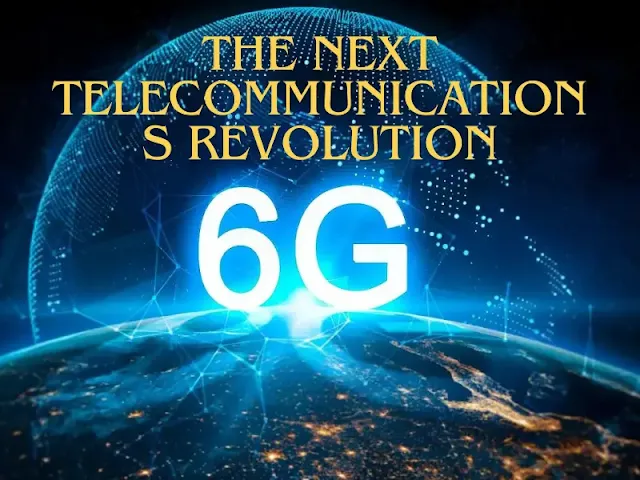6G: The Next Telecommunications Revolution
The journey of communication technologies is nothing short of extraordinary, from the rudimentary 1G to the cutting-edge promise of 6G. This narrative delves into this remarkable evolution, spotlighting the impending need for 6G as the number of connected devices is forecasted to skyrocket to 500 billion by 2030.
History of Communication Generations
1G: The Beginning
In the 1980s, the world witnessed the birth of 1G, the first generation of mobile telecommunications. It was a marvel of its time, solely facilitating voice calls. Despite its rudimentary nature, 1G laid the groundwork for the technological marvels that followed.
2G: A Step Forward
The 1990s heralded the advent of 2G, which brought about SMS (Short Message Service) and MMS (Multimedia Messaging Service). With data speeds in kilobits per second, 2G significantly bolstered voice communication quality and introduced basic data services, marking a significant leap from its predecessor.
3G: The Rise of Mobile Internet
Entering the early 2000s, 3G emerged, bringing mobile internet into the mainstream. Speeds in megabits per second allowed for web browsing, email, video calls, and streaming media on mobile devices, vastly enhancing the realm of mobile communication.
4G: High-Speed Connectivity
The 2010s saw the rise of 4G, offering high-speed mobile internet with vastly improved data transfer rates. This generation enabled HD video streaming and rapid file transfers, supporting the burgeoning Internet of Things (IoT) and further integrating connected devices into daily life.
5G: The Wireless Fiber Optic Revolution
In the 2020s, 5G revolutionized the landscape with speeds in the hundreds of megabits per second. Leveraging wireless fiber optics, 5G boosted connectivity and slashed latency, paving the way for advancements in autonomous driving, smart cities, and a plethora of connected devices.
The Need for 6G
The relentless growth in connected devices will soon outpace 5G's capabilities. Hence, since 2019, 6G development has been in progress, aiming to deliver unparalleled speed and connectivity to meet future demands.
6G Technology
Terahertz (THz)
At the heart of 6G lies Terahertz (THz) technology, promising data transfer speeds up to an astonishing 1 THz—50 times faster than 5G. This leap will cater to the ever-growing data needs of forthcoming applications and devices.
Latency
One of the standout advancements with 6G is the dramatic reduction in latency to 0.1 microseconds. This ultra-low latency will facilitate real-time communication and interaction, crucial for remote surgery, immersive virtual reality, and other latency-sensitive applications.
Massive MIMO Antenna
The evolution of Massive MIMO (Multiple Input Multiple Output) technology will significantly enhance antenna precision and capacity, enabling a higher number of simultaneous connections with greater reliability.
Expected Advances
Increased Traffic
6G is anticipated to handle traffic volumes five times greater than 5G, accommodating the rapid escalation in data consumption and device connectivity.
Enhanced Reliability
With unparalleled precision and reliability, 6G will offer more dependable communication services, vital for critical sectors such as healthcare, transportation, and industrial automation.
Proliferation of Connected Devices
Supporting hundreds of smart objects per cubic meter, 6G will propel the IoT forward, enabling smart environments in homes, cities, and industries.
Extended Battery Life
Aiming for enhanced energy efficiency, 6G could potentially extend battery life to over 20 years for connected devices, achieving this through tenfold improvements in energy management systems.
Challenges and Solutions
Wave Propagation
Higher frequency waves in 6G face challenges like shorter propagation distances and increased susceptibility to obstacles. Addressing these issues will require cutting-edge technologies and innovative solutions in wave propagation.
Cognitive Radio
Cognitive radio technology will optimize frequency usage, ensuring efficient and effective communication by dynamically harnessing unused spectrum.
Global Competition
Competing Countries
The global race to develop 6G technology is fierce, with leading efforts from China, the USA, South Korea, Taiwan, India, and the European Union.
Transmission Speed Records
China has set a remarkable benchmark by achieving a transmission speed of 100 gigabits per second, underscoring the immense potential of 6G technology.
Availability and Environmental Impact
Availability
6G is slated for availability by 2030. However, addressing environmental impact and deployment logistics will be crucial to ensure sustainable and widespread implementation.
Futuristic Applications
6G will enable visionary applications such as immersive augmented reality, mobile holograms, and digital replicas, transforming human interaction with technology and each other.
Conclusion
Technological Challenges
The path to 6G development will demand significant advancements in materials, architecture, and computing technologies. These challenges are substantial but essential for achieving the next leap in telecommunications.
Promising Future
Despite its complexity, the future of 6G shines brightly. With deployment expected before 2030, 6G will revolutionize communication, driving innovation and connectivity to unprecedented heights.



